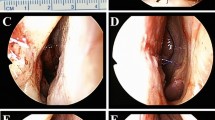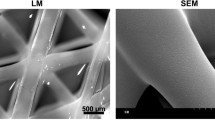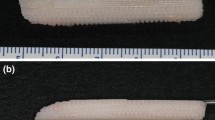Abstract
Background
This clinical study aimed to investigate the safety and surgical outcome of three-dimensionally (3D) fabricated polycaprolactone (PCL) mesh in rhinoplasty. In particular, this study explored how a 3D-printed PCL mesh performs as a bioabsorbable scaffold after a long period following implantation.
Methods
A retrospective review of 101 patients who received primary or secondary rhinoplasty with a PCL mesh was performed. Patient demographics and surgery-related outcomes were examined. Clinical efficacy and safety were evaluated using the Global Aesthetic Improvement Scale at postoperative 18 months. From two revisional cases, a biopsy specimen of implanted PCL was acquired and histopathological analysis was performed.
Results
Of all the patients, 98.0% showed no postoperative infection-related foreign body reaction or distinct abnormal reaction, and the implants were observed to maintain long-term efficacy until 18-month follow-up. In patients who received spreader grafts, significant differences between preoperative and postoperative Cottle sign scores were found. Histopathological analysis showed features of adjacent tissue infiltration into pores of the PCL mesh and regeneration of neo-cartilaginous tissue and collagen around the mesh 20 months after implantation.
Conclusion
This study demonstrates that a novel biodegradable PCL mesh with a 3D structure is a safe and effective material for corrective rhinoplasty because it is easy to use and capable of maintaining its volume in the long term without foreign body response. This biocompatible material will have a wide range of applications as the most suitable alternative to nonabsorbable materials in rhinoplasty and reconstruction surgeries, such as fashioning spreader grafts and septal extension grafts.
Level of Evidence IV
This journal requires that authors assign a level of evidence to each article. For a full description of these Evidence-Based Medicine ratings, please refer to the Table of Contents or the online Instructions to Authors www.springer.com/00266.








Similar content being viewed by others
References
Jin HR, Lee JY, Shin SO, Choi YS, Lee DW (2006) Key maneuvers for successful correction of a deviated nose in Asians. Am J Rhinol 20:609–614
Sajjadian A, Naghshineh N, Rubinstein R (2010) Current status of grafts and implants in rhinoplasty: part II. Homologous grafts and allogenic implants. Plast Reconstr Surg 125:99e–109e
Kim HS, Park SS, Kim MH, Kim MS, Kim SK, Lee KC (2014) Problems associated with alloplastic materials in rhinoplasty. Yonsei Med J 55:1617–1623
Woodruff MA, Hutmacher DW (2010) The return of a forgotten polymer—polycaprolactone in the 21st century. Prog Polym Sci 35:1217–1256
Park SH, Yun BG, Won JY et al (2017) New application of three-dimensional printing biomaterial in nasal reconstruction. Laryngoscope 127:1036–1043
Kim YS, Shin YS, Park DY et al (2015) Application of three-dimensional printing in animal model of augmentation rhinoplasty. Ann Biomed Eng 43:2153–2162
Shim JH, Jeong JH, Won JY et al (2017) Porosity effect of 3D-printed polycaprolactone membranes on calvarial defect model for guided bone regeneration. Biomed Mater. 13:015014
Stal S, Hollier L (2000) The use of resorbable spacers for nasal spreader grafts. Plast Reconstr Surg 106:922–928 (discussion 929–931)
Rhoda S, William P, Lisa M et al (2010) Improvement in nasolabial folds with a hyaluronic acid filler using a cohesive polydensified matrix technology: results from an 18-month open-label extension trial. Dermatol Surg 36:1800–1808
Park CH, Kim IW, Hong SM, Lee JH (2009) Revision rhinoplasty of Asian noses: analysis and treatment. Arch Otolaryngol Head Neck Surg 135:146–155
Park JH, Jin HR (2012) Use of autologous costal cartilage in Asian rhinoplasty. Plast Reconstr Surg 130:1338–1348
Caughlin BP, Been MJ, Rashan AR, Toriumi DM (2015) The effect of polydioxanone absorbable plates in septorhinoplasty for stabilizing caudal septal extension grafts. JAMA Facial Plast Surg 17:120–125
Boenisch M, Mink A (2000) Clinical and histological results of septoplasty with a resorbable implant. Arch Otolaryngol Head Neck Surg 126:1373–1377
Chen CC, Chueh JY, Tseng H, Huang HM, Lee SY (2003) Preparation and characterization of biodegradable PLA polymeric blends. Biomaterials 24:1167–1173
Eppley BL, Reilly M (1997) Degradation characteristics of PLLA-PGA bone fixation devices. J Craniofac Surg 8:116–120
Schantz JT, Teoh SH, Lim TC, Endres M, Lam CX, Hutmacher DW (2003) Repair of calvarial defects with customized tissue-engineered bone grafts I. Evaluation of osteogenesis in a three-dimensional culture system. Tissue Eng 9(Suppl 1):S113–S126
Acknowledgment
None of the authors has a financial interest in any of the products, devices, or drugs mentioned in this manuscript.
Author information
Authors and Affiliations
Corresponding authors
Additional information
Dr. So Young Kim and Young Jin Park were equally contributed as co-corresponding authors to this article.
Electronic supplementary material
Below is the link to the electronic supplementary material.
Supplemental Video 1. Surgical implantation technique using PCL mesh for a spreader graft, septal extension graft and columellar strut. (MP4 74936 kb)
Rights and permissions
About this article
Cite this article
Park, Y.J., Cha, J.H., Bang, S.I. et al. Clinical Application of Three-Dimensionally Printed Biomaterial Polycaprolactone (PCL) in Augmentation Rhinoplasty. Aesth Plast Surg 43, 437–446 (2019). https://doi.org/10.1007/s00266-018-1280-1
Received:
Accepted:
Published:
Issue Date:
DOI: https://doi.org/10.1007/s00266-018-1280-1




